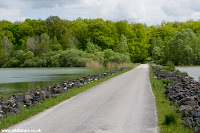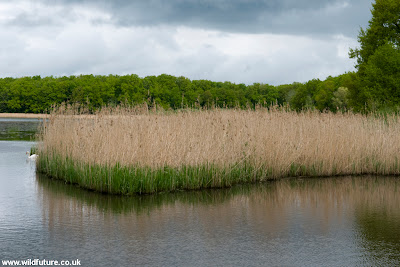Labrador Bay RSPB reserve (June 2014)
Leaving Woking at 5.30am, it was a beautiful drive down the A303 on a bright and sunny morning - an atmospheric mist around Stonehenge was the only time all day that the sun was not beating down. By 8.15am, I was standing in the car park atop Labrador Bay, 3km south of Teignmouth, watching and listening to two singing male Cirl Buntings perched on the thick hedgerows. [Listen to them yourselves!]
This was my first visit here - Labrador Bay was acquired by the RSPB in 2009, four years after I moved on from being their Regional Reserves Manager for south-west England. We'd spent a great deal of time looking for the perfect reserve area to provide a safe home for Cirl Buntings and it was a pleasure to finally be there.
Cirl Bunting by Andy Morffew via Creative Commons
Looking north across the reserve
It's a tremendous view from the car park. The grassland and arable fields tumble beautifully down the hill to the cliff tops. It was somewhat hazy today; Hope's Nose was clear along the coast to the south but Portland was a smudge on the north-east horizon.
Looking south to Maidencombe, Torquay and Hope's Nose
I strolled just half a kilometre into the undulating reserve to the south, along the edge of one of the arable fields and sat looking across a scrubby downslope to more grassland and, beyond, to Maidencombe and Hope's Nose. This was a spot I occupied for the next half an hour and could have stayed much longer at. Whitethroats, Goldfinches, Skylarks, a Goldfinch and a Greenfinch were singing. Three more Cirl Buntings, two females and a male, alighted briefly on a branch in front of me, giving great views.
A male Linnet perched in a shrub close by for several minutes and another male's song came from across the hillside. A Raven drifted along the cliff tops, calling, and a Common Buzzard hunted across the opposite slope of the field. Offshore, a Gannet was cruising and diving. Foxgloves added colour in every direction and a Giant Puffball was on the ground nearby. I probably wasn't paying enough attention but Marbled White and Small Copper butterflies can be seen here.
Giant Puffball (Calvatia gigantea)
With the rush hour through Teignmouth over, I made may way back to the car and took the A379 north along the coast. I took a short walk along the beach and nature reserve at Dawlish Warren, more for nostagalgia than anything else, enjoying the Evening Primroses flowering in the sandy areas near the car park (despite being invasive non-natives). Only a Black-headed Gull appeared to be offshore - no Great Northern Divers or scarcer gulls, although some were seen later that day.
Dawlish Warren south beach (above) and nature reserve (below)
And so it proved. The hide was relatively full and I took to leaning against the rear wall with my scope, listening to the words of wisdom from others whilst I scanned the pool. The first bird I laid eyes on was an adult Spoonbill in the channel close to the hide - superb! There were around 800 Black-headed Gulls in three groups around the pool but with several gems inter-mixed. There were some Mediterranean Gulls wading, and I had great views of second summer and adult birds. A Bonaparte's Gull was loafing on the water - only the second I had seen - and a Little Gull rested in the bay. And on the back mud shore - the Ross's Gull was just visible amongst the Black-heads. The world's two smallest gull species in the same place - fantastic. I'm not that fond of gulls but with Common and Herring Gulls also present, it was quite a collection.
The high-tide roost at Bowling Green Marsh RSPB
There was also a big group of waders present in front of the reedbed at the back. I was pleased to see about five Bar-tailed Godwits amongst the Black-taileds and, on the edge of a group of 80 or so Redshank, two Spotted Redshanks in their glorious black and speckled summer plumage - both species I don't see too regularly. Four Whimbrel were also present to make a great trio.
(above) Mediterranean Gull in flight, by Maarten van Kleinwee, via Creative Commons,
and a beautiful Spotted Redshank by Michele Lamberti, via Creative Commons (below)
and a beautiful Spotted Redshank by Michele Lamberti, via Creative Commons (below)
After an hour or so I was preparing to leave when a discussion broke out about an odd looking Herring Gull on the far bank - or was it a Caspian Gull, a rarity in Devon? We knocked some ideas around for a while and came to the conclusion it probably was just a Herring Gull - but it was an informative debate which is encapsulated in this blog post from Tim Worfolk.
No visit would be complete without a stroll on the Pebblebed Heaths and I stopped off at Woodbury Common and Aylesbeare Common RSPB reserve for some more fresh air and exercise.
Woodbury Common (above) and Bicton College (below)
The final call of the day was at my alma mater, Bicton College, near East Budleigh, which specialises in land-based and environmental education. There's some improved accommodation and new facilities, but it retains the same 'small school' feel I remember from the mid-90s. Maybe I'll see if I can do a refresher or two there!
And so the day ended with the drive back to Surrey, not disturbed too much by the pre-solstice traffic management - perhaps June 20th isn't the best day for this drive but it didn't hold me up for long. A fantastic day out.































































